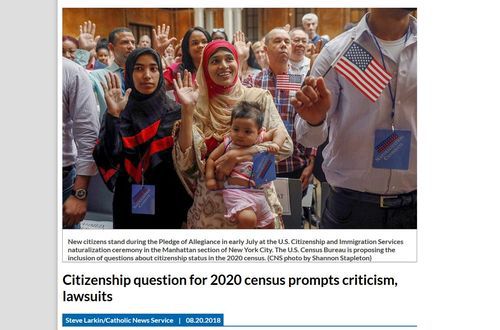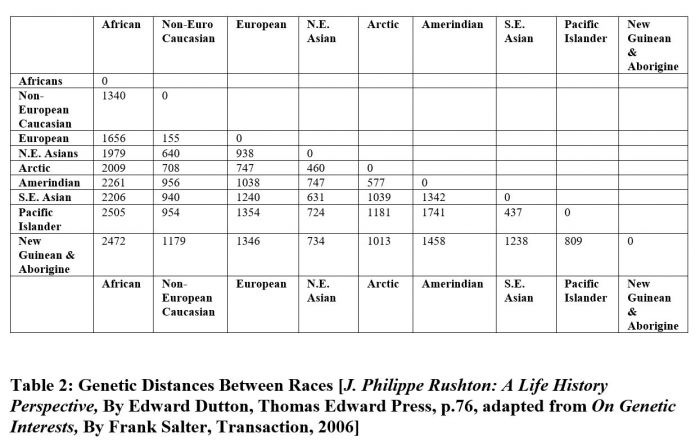


By Lance Welton
09/08/2018
The next US Census is scheduled for 2020. Apparently the Trump Administration has not fallen for Obama Era plans to change the questions on race to further reconstruct America, although it does want to revive the 1890-1950 practice of asking about citizenship, shamelessly opposed by the usual suspects and the kritarchy.[See Citizenship question for 2020 census prompts criticism, lawsuits, by Steve Larkin, Catholic News Service, August 20, 2018 and Trump Officials Say They Can’t Recall Discussing Census Citizenship Question, by Hansi Lo Wang, NPR, September 5, 2018] Which is good, but what’s really necessary is to go onto the offensive: make the census questions reflect what modern science says about “race.”
America’s Ruling Class has a schizophrenic attitude towards race. If you want to talk about issues like crime or immigration, then “race” is a social construct with no biological basis and if you disagree then you’re worse than Hitler. However, when it comes to Affirmative Action, or noticing that minorities disproportionately suffer from certain congenital illnesses, then “race” magically becomes both biological and painfully real.
The problem, as two recent books on race show in painstaking detail: the racial categories used on all government forms in the US are, biologically, nonsense.
The typical US government form — where you’re asked to fill in your ethnicity — differs depending on who issues it. But in general, the Liberal Elite’s “Races of Man” are: White, Black, Hispanic (sometimes divided into Hispanic White and Hispanic Non-White), Asian, Pacific Islander and Native American. Sometimes, to make things even worse, you find options such as “Native American, Pacific Islander and Alaskan Native” or simply “API” — “ Asian-Pacific Islander.”
But in his soon-to-be-published book, Race Differences in Psychopathic Personality, British psychologist Professor Richard Lynn sets out a huge body of data implying that US race categories are simply not fit for purpose.
A “race,” he tells us, is a breeding population separated long enough from another breeding population to have adapted to a different ecology, leading to consistent differences in average gene frequencies between the populations. This is important because, as Lynn shows, “race,” therefore, expresses itself in consistent interrelated physical and mental differences, which tend to differ in the same direction because they are adaptations to distinct environments. Thus, different races have different genetic disease profiles, different dominant blood groups, different average IQ, and different modal personalities.
Another recent book, J. Philippe Rushton: A Life History Perspective by Lynn’s colleague Edward Dutton, presents evidence for the minutiae of these consistent race differences: in age at menopause, in the kind of face and body found the most attractive, in preference for oral over vaginal sex, and even in ear wax composition.
These studies set out the genetic assay data which proves that there are about 10, and possibly 12, distinct races:
The last two are sometimes being subsumed into “African” while North African, Arabs and South Asians are sometime merged into “Non-European Caucasian.” Lynn’s book demonstrates that these races differ in something as important as as average level of psychopathic personality; a condition defined by reckless behavior, criminality, impulsivity, cheating, marital breakdown, selfishness and lack of empathy. So, simply to stay safe, it’s worth properly understanding what the actual “races of man” are. And understanding this reveals what nonsense official US race categories are.
|
RACE |
IQ |
PP |
|
Australian Aborigines |
62 |
6.0 |
|
Sub-Saharan Africans |
70 |
7.5 |
|
New Zealand Maori |
84 |
5.9 |
|
Native Americans -USA |
86 |
2.2 |
|
South Asians — Britain |
92 |
1.0 |
|
Europeans |
100 |
1.0 |
|
Northeast Asians–Britain |
105 |
0.7 |
Race differences in intelligence and psychopathic personality (PP): Race differences in IQ and rates of crime (odds ratios, Europeans set at 1.0) [Richard Lynn, Race Differences in Psychopathic Personality, Washington Summit, In Press, Table 16: 2].
The silliest race categories used by the US government are “Native American, Pacific Islander and Alaskan Native” and “API.” Pacific Islanders have little genetically in common with either of these races. The genetic distance between a Pacific Islander and a Native American is about quadruple the distance between a Pacific Islander and a Southeast Asian, someone from, for example, Cambodia or Malaysia (see Table 2, below). The distance between Alaskans and Pacific Islanders is triple that which exists between Southeast Asians and Pacific Islanders.
This makes sense, of course, because Pacific Islanders broke away from Southeast Asians. To put it another way, the category “API” is a bit like having a race group called European-Australian Aborigine, the difference between these races being only slightly more than that the between Pacific Islanders and Native Americans.
The latter, being so different, also have far higher rates of psychopathic personality.

The category “Asian” is also extremely problematic, as it encompasses Northeast Asians, Southeast Asians and South Asians; the latter often stretching to include Middle Easterners and North Africans.
South Asians — “Indians” — are a Caucasian people. The genetic distance between South Asians and Northeast Asians is more than quadruple the difference between South Asians and Europeans, this rises to sextuple when comparing South Asians and Southeast Asians. And Northeast Asians are 1.6 times more similar to the Arctic peoples (such as the Inuit and Alaskans) than they are to Southeast Asians.
In other words, the category “Asian” has zero basis in genetics. It’s only slightly more justifiable than combining Indians and Inuit into one racial category.
Unsurprisingly, the differences within the Asian category are striking. Northeast Asians have an average IQ of 105 whereas South Asians have an average IQ of about 92 when living in Western countries. South Asians are also far more psychopathic than Northeast Asians, though about the same as Europeans, which Lynn suggests is due to South Asian adaptation to very crowded environments.
But this falls apart with the API category. Not only do Pacific Islanders have higher levels of psychopathic personality than Asians or Europeans but, due to the complications of racial migrations and separations, they are more similar to Australian Aborigines than they are to South Asians.
And as Lynn explains, the category Hispanic — though it has some utility — is basically a mess.
In general, Hispanics are a cline; a mixture of two races, specifically Native Americans and Europeans. On most measures of psychopathic personality, they, unsurprisingly, fall between Europeans and Native Americans, leaving them with lower average levels of psychopathic personality than Africans. However, the category “Hispanic” often includes many who are from South America, who, in some cases, may be more genetically European that some ‘White Americans,’ who may have small amounts of Native American or African American ancestry.
Clines mean that there is a cultural element to “race.” Why are Greeks European but Western Turks not? There are always things that don’t quite fit into any system of categories.
But let’s be clear: from a genetic perspective, “race” exists and predicts very important things, such as psychopathic personality.
America’s official racial categories, however, predict very little…possibly because those who come up with them find it so psychologically conflicting to have to think about “race" at all.
Lance Welton is the pen name of a freelance journalist living in New York.